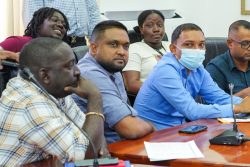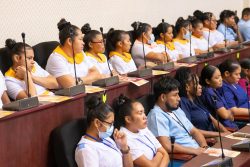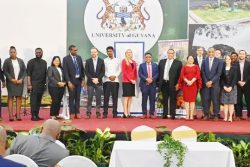![]() Locust (Hymenaea courbaril) or ‘Stinking Toe’, grows on both clay and sandy soils and can be found along rivers in mixed Mora forests and marsh forests. It is widely distributed and especially common in Eastern Guyana. The leaves are alternate (occurring opposite each other), bright green and leathery in texture. The bark is light brown to red brown or grey, often with light horizontal bands, smooth or rough with many warty pores, and cracked. This beautiful tree often grows straight and cylindrical up to 50 metres tall. This hardwood has a beautiful grain and has an orange brown to red brown colour, and as a result is an important timber species for Guyana. The very hard, strong wood of decorative appearance has proved its suitability for the manufacture of high grade furniture, cabinet work, decorative joinery and veneer.
Locust (Hymenaea courbaril) or ‘Stinking Toe’, grows on both clay and sandy soils and can be found along rivers in mixed Mora forests and marsh forests. It is widely distributed and especially common in Eastern Guyana. The leaves are alternate (occurring opposite each other), bright green and leathery in texture. The bark is light brown to red brown or grey, often with light horizontal bands, smooth or rough with many warty pores, and cracked. This beautiful tree often grows straight and cylindrical up to 50 metres tall. This hardwood has a beautiful grain and has an orange brown to red brown colour, and as a result is an important timber species for Guyana. The very hard, strong wood of decorative appearance has proved its suitability for the manufacture of high grade furniture, cabinet work, decorative joinery and veneer.
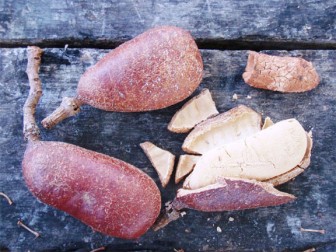
Locust flowers mainly in May and June and bats are its primary pollinators. Broad, oblong seed pods are a rich, reddish brown and the seeds are embedded in a light green or yellow mealy pulp. When in season, the fruit can sometimes be found on sale in markets. The pulp is edible and sweet tasting but has a strange unpleasant smell, hence the common name of ‘Stinking Toe’.
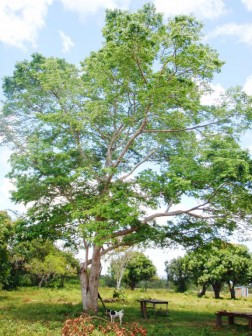
Animals such as saki and capuchin monkeys and rodents such as agoutis and labba eat the fruits and as a result, these animals are important seed dispersers for this species.
Locust is called ‘Maireye’ in Makushi and the bark from the Eastern side of the tree is scraped off, boiled, cooled and is administered one spoon at a time to cure bloody diarrhoea. The gum of the trunk is also used for curing wounds and as incense.
Rain forests are rich in biodiversity and are home to many different plants and animals. In addition, indigenous communities make their homes there. Even if you don’t live in the rain forest, humans rely on the forest for resources such as building materials (wood and lianas), medicine and fruits. Rain forests also provide essential environmental services for life on earth; they create soil as well as prevent soil erosion, produce oxygen though photosynthesis, maintain clean water systems, and are a key defence against climate change.
The Iwokrama Rain Forest is 371,000 hectares, located in the heart of Guyana. Our mission is to develop strategies for conservation and sustainable development for local people in Guyana  and the world at large. We are involved in tourism, training, research and our timber is certified by the Forest Stewardship Council. Come and visit us in the rain forest or at http://www.iwokrama.org.
and the world at large. We are involved in tourism, training, research and our timber is certified by the Forest Stewardship Council. Come and visit us in the rain forest or at http://www.iwokrama.org.


